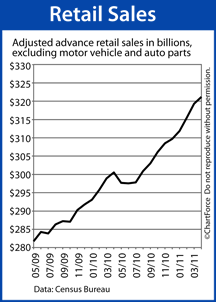 Another day, another piece of evidence that the U.S. economy is expanding.
Another day, another piece of evidence that the U.S. economy is expanding.
Thursday, the Census Bureau released the April Retail Sales report. Excluding cars and auto parts, retail receipts rose for the 10th straight month and, at $321 billion, reached an all-time high.
Retail sales account for roughly half of consumer spending, and roughly one-third of the economy overall.
For home buyers and rate shoppers in Minneapolis , the sales figures have positive and negative implications.
On the positive side, more retail sales suggests more confidence in the U.S. economy. This can spark a growth cycle that benefits the country, on the whole.
- Consumers spend more money
- Businesses sell more product
- Businesses expand payroll to meet new product demand
- Governments collect more taxes; fund more projects
- Consumers gain more confidence and the cycle repeats
Furthermore, rising employment rates help to support higher levels of home sales which, in turn, can lead to higher home prices in Minnesota.
This is why Retail Sales data is so important to Wall Street and economists. It can hold clues to the future of the U.S. economy.
On the negative side, however, rising Retail Sales figures can harm home affordability. In addition to the aforementioned pressure on home prices, a strengthening economy can lead to higher mortgage rates. The weak economy of 2009-2010 is a major reason why mortgage rates were so low for so long.
As the economy improves, therefore, it follows that rates should reverse.
Each 1/8 percent increase to mortgage rates raises a mortgage payment $8 per $100,000 borrowed.
Retail Sales are up 7 percent from a year ago.
